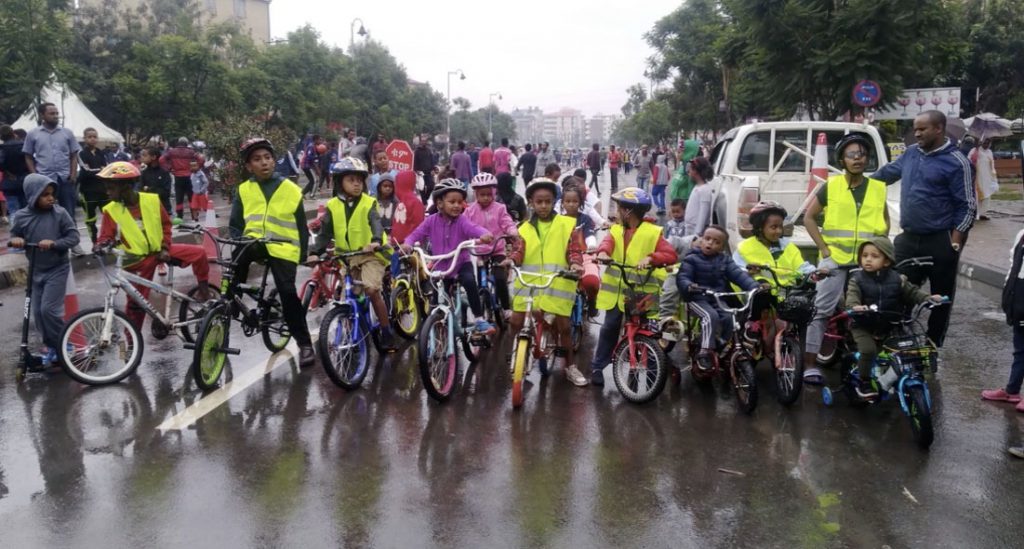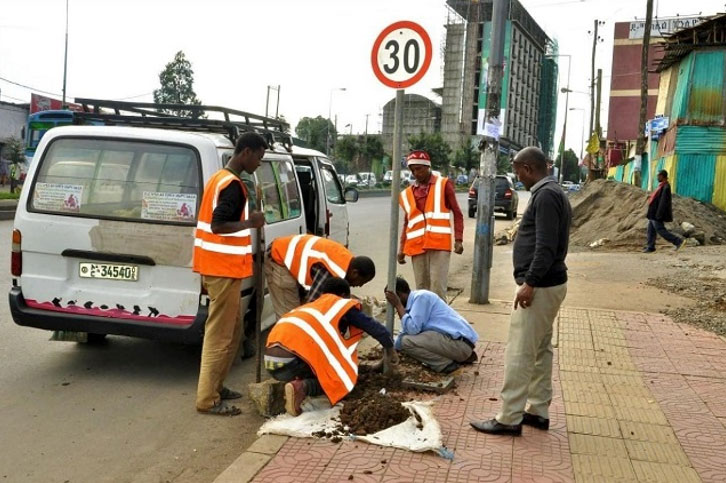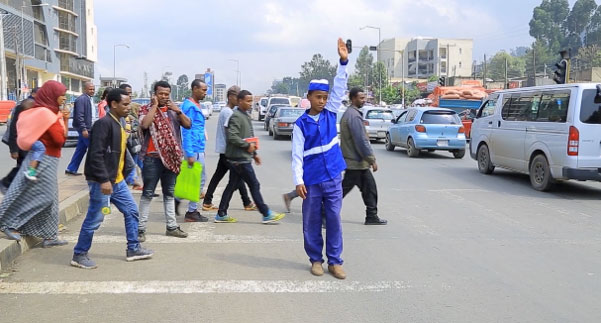Addis Ababa, Ethiopia: Making a strong commitment to pedestrians with a focus on children
Winner of the 2021 Vision Zero for Youth Leadership Award! View the press release.
Download this Success Story as a PDF.
In 2016, Addis Ababa committed to a major shift in transportation priorities from building motor vehicle-focused roads to prioritizing efficient public transport and high-quality facilities for walking and cycling. The city’s Road Safety Strategy identified pedestrians as the most at-risk to die. In fact, crash data analysis showed that walking comprised 54 percent of trips, yet more than 86 percent of all roadway fatalities. Focusing on pedestrians and cyclists held the highest potential for reducing roadway deaths in Addis Ababa.

Young bikers participate in a children’s bike race on a Car Free “Streets for People” Day in Addis Ababa, Ethopia. Photo source: Addis Ababa Traffic Management Agency.
Addis Ababa also recognized that children are one of the most vulnerable road users in the city and initiated a road safety program focused on schools, as part of its larger Road Safety Strategy Implementation Plan.
Specifically, the Addis Ababa Road Safety Program focused on four key strategies to enhance safety for youth travel:
- prioritizing youth pedestrians in road safety policy;
- decreasing speed in school zones;
- providing and improving pedestrian infrastructure in school zones; and
- promoting, encouraging, and supporting monthly Car Free “Streets for People” Days to help shift mindsets away from motor vehicles and to create safe play spaces for youth.
Safe System Approach
The program is based on a Safe System approach which moves away from individual responsibility to system accountability for roadway safety. The key principles of the Safe System approach are that:
- humans make errors;
- humans are vulnerable to injury;
- responsibility for transportation safety is shared;
- no death or serious injury is acceptable on our roadways; and
- safety improvements must be proactive rather than reactive.
Commitment and sustainability across political administrations
These ambitious strategies were only possible because of sustained political will. Elected officials from different political administrations worked together to share and build upon road safety programs for Addis Ababa. The Addis Ababa City Administration, under the leadership of previous mayors, established a lead agency for road safety which was an integral part of prioritizing and scaling road safety initiatives in the city in 2014/15. The agency also served as the secretariat for the Addis Ababa Road Safety Council, which ensures progress on the goals of the road safety strategy, as well as implementation, transparency and accountability of the plans. Since the appointment of Mayor Adanech Abebe in 2021, the city administration together with the Addis Ababa Transport Bureau and the Addis Ababa Traffic Management Agency is continuing to advance the road safety work and recently launched a second phase of the Road Safety Strategic Implementation Plan.

Representatives of the Addis Ababa Traffic Management Agency accepted the 2021 International Vision Zero for Youth Leadership Award trophy on behalf of Addis Ababa, Ethiopia, in May, 2021. Photo source: World Resources Institute.
Recognized for International Vision Zero for Youth Leadership
In 2021, Addis Ababa, Ethiopia, and Bogotá, Colombia, received the International Vision Zero for Youth Leadership Award for their long-standing commitments to a culture of safe and active transportation for children and youth.
Focus on decreasing speeds
In 2015, the World Resources Institute (WRI), through the Bloomberg Philanthropies Initiative for Global Road Safety, began working with the city government in Addis Ababa to develop comprehensive speed management plans to reduce speeds through evidence-based policy improvements, safer street design, better enforcement, and public awareness campaigns.

30 kph speed limit signs were installed across Addis Ababa. Photo source: Addis Ababa City Administration Traffic Management Agency.
The Addis Ababa Road Safety Program aimed to increase safety and convenience for children through two main street design improvements:
- providing and improving pedestrian infrastructure in the school zone; and
- implementing speed reduction interventions to lower speeds to 30km/h.
Crash data for children six through 15 years of age were used to map high crash areas around schools. Within 12 months, 50 school zones were examined in this mapping exercise. Road safety improvements made through this effort included establishing school zone speed limits of 30 kph, properly marking crosswalks, and introducing speed reduction measures, such as speed humps and rumble strips.

Engineering improvements focused on identified problem areas, such as crosswalks across high traffic volume roadways. Photo source: Addis Ababa City Administration Traffic Management Agency.

Speed management improvements included the installation of rumble strips (left) and speed humps (right). Photo source: Addis Ababa City Administration Traffic Management Agency.
Importance of infrastructure improvements
Focusing on infrastructure needs citywide−with an eye toward the safety of youth−was another important element of the success of its efforts.
The Addis Ababa Road and Transport Bureau began expanding sidewalks, adding separate lanes for bicyclists, improving intersection crossings, and improving the quality of public spaces throughout the city. More than 87 km of pedestrian walkways were built as part of the Addis Ababa Road Safety Program.
LeGare intersection is an example of the results that improvements like curb extensions, reductions in crossing distance and medians, and safe waiting areas can have. There have been no fatal crashes since the infrastructure transformation in 2016 and a 50 percent reduction in injury crashes.

LeGare intersection before (left) and after improvements (right). Photo source: Global Designing Cities Initiative.

Ayer Tena before (left) and after (right) creating pedestrian crosswalks. Photo source: Addis Ababa City Administration Traffic Management Agency.
Other types of infrastructure improvements

(Left to right) Protected places for walking and biking, high visibility crosswalks with push button signals, cylindrical bollards. Photo source: Addis Ababa City Administration Traffic Management Agency.
Shifting mindsets

Car Free Day celebrates physical activity, community, and fun. Photo source: Addis Ababa City Administration Traffic Management Agency.
The initial Addis Ababa Road Safety Program included campaigns to increase driver awareness in the school zone areas and drivers are accepting speed reductions around schools. The long-term plan is to have stricter policies when determining the location and design of schools to consider factors such as land use and traffic volumes. Car Free “Streets for People” Days are conducted once per month to help change mindsets away from motor vehicle use and to create play space, especially for low- and middle-income children. More than 5,000 students receive training and participate in the student traffic police. These students will carry this training with them as they become adults.

Student traffic police support pedestrian safety. Photo source: Addis Ababa City Administration Traffic Management Agency.
Moving forward
Demonstration projects and community engagement with students, parents and teachers have been important components for building buy-in. Motorists are accepting speed reductions around schools and concern for children is seen as an entry point for addressing road safety.
Now these efforts are being shifted to build national momentum as Car Free Day has spread to seven regions in the country. A national non-motorized strategy, which is called National Road Safety strategy and scaled from Addis Ababa’s non-motorized strategy launched in 2020, was launched in July 2022.
According to SSATP, 650 people die on Africa’s roads every day, and 39 percent of fatalities are among pedestrians and other vulnerable road users like children. The commitment of Addis Ababa serves as an excellent example that holds great promise for other cities, especially in Africa which is the least motorized region globally yet has the highest road traffic fatality rates.
